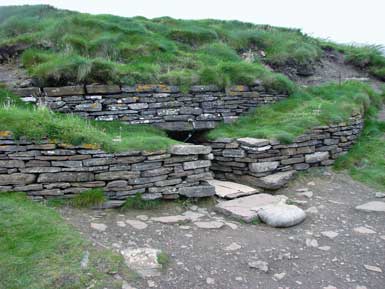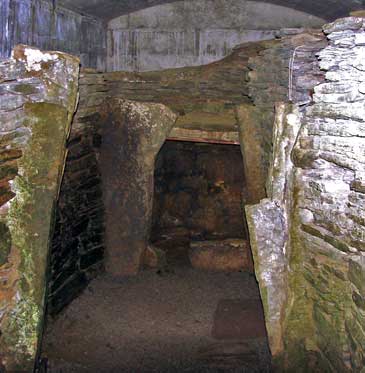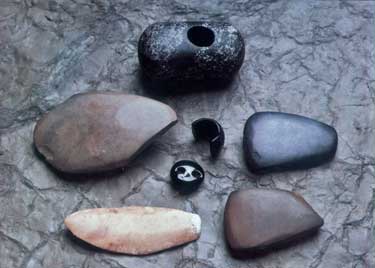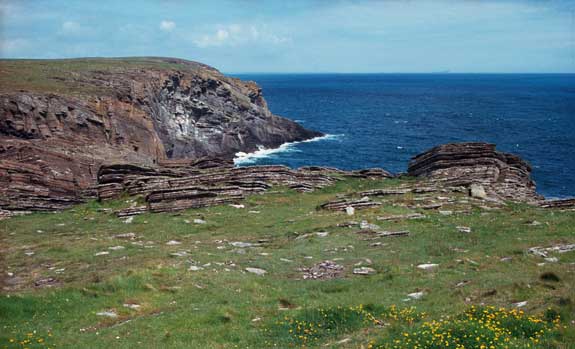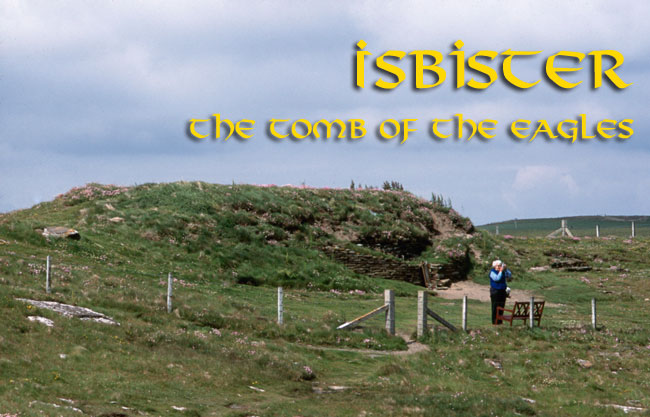
Cliffs at Isbister, South Ronaldsay
The tomb is located near the edge of a high cliff on the east coast of South Ronaldsay. The existence of the tomb was revealed in 1958 when the landowner, Ronald Simison, began to remove stone to build a fence and immediately came upon a cache of objects that were all neolithic in date. In the 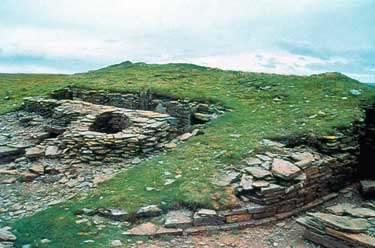 absence of any ‘official’ interest excavations were resumed by Simison in the 1970’s using techniques he had learned from observing the work of Colin Renfrew and John Hedges at the Bronze Age site of Liddle, also on his property. These later excavations showed that the site had been disturbed, probably by earlier quarrying, and that much of the superstructure had been removed—especially on the seaward side.
absence of any ‘official’ interest excavations were resumed by Simison in the 1970’s using techniques he had learned from observing the work of Colin Renfrew and John Hedges at the Bronze Age site of Liddle, also on his property. These later excavations showed that the site had been disturbed, probably by earlier quarrying, and that much of the superstructure had been removed—especially on the seaward side.
A four metre stretch of the entrance passage remains where it enters the side of the burial chamber at a slight angle from the east.. The burial chamber is 8.2 metres long and between 1.2 and 1.6 metres across with walls that still stand as high as 2 metres. It is an unusual hybrid, containing features of both Maes Howe and Stalled tombs. The unpaved central part of the tomb has been divided into three compartments but the distinction is minimal since, at best, the uprights only project a few centimetres from the wall. The two end compartments, on the other hand, are very clearly set apart from the rest of the tomb. They are about 60 cm wider and there are stone sills about 30 cm high at their entrances. There was a terminal slab in each and they were provided with flagstone shelves set well over a metre above the floor. Some human and animal bones had been left,
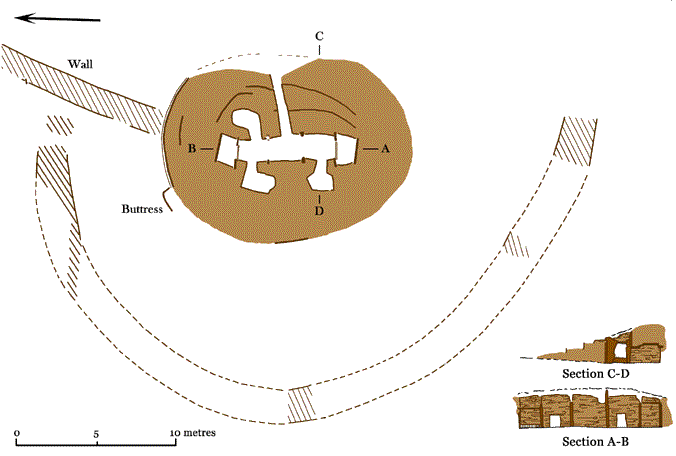
Isbister. Plan & Sections of the Tomb of the Eagles
presumably as a foundation deposit, in a cavity beneath the single flagstone that formed the floor of the southern compartment, but the northern one had been completely cleared at some point in the recent past. As at Unstan, there are side cells—two on the west side and one on the east. In each case, a short, low passage leads from the main chamber to an irregularly shaped space about 1 metre deep and between 1.5 and 2 metres across. Unfortunately, the eastern cell had been 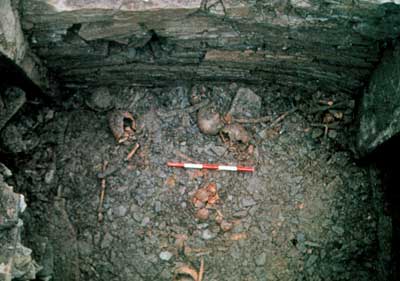 emptied, presumably at the same time as the other areas but the northern one had been completely cleared at some point in the recent past. As at Unstan, there are side cells—two on the west side and one on the east that had also been emptied. In each of them, a short, low passage leads to an irregularly shaped space about 1 metre deep and between 1.5 and 2 metres across.
emptied, presumably at the same time as the other areas but the northern one had been completely cleared at some point in the recent past. As at Unstan, there are side cells—two on the west side and one on the east that had also been emptied. In each of them, a short, low passage leads to an irregularly shaped space about 1 metre deep and between 1.5 and 2 metres across.
Although the upper levels of the main chamber had been badly disturbed a lot of material, including human and animal bone along with cultural material, was recovered lower down. Most of the human bones came from the floor and were mainly found in heaps along the walls—a skull along with an assortment of other bones in each pile. The two excavated cells, on the other hand, contained mainly skulls. 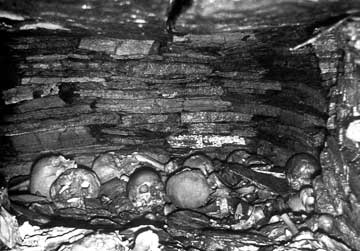
Altogether, the remains of some 338 individuals were recovered and there had presumably been many more in the in the areas that had been emptied. Among the skeletons whose sex could be determined, 93 were male and 38 female. They range in age from foetal to about 50—185 adults, 62 teenagers, 70 children and 14 infants/foetal. Only about 5 per cent were over the age of 40.
A fair amount of pottery, including typical Unstan bowls, was discovered in the tomb, mainly on the area of floor opposite the entrance. In addition, several flint scrapers were found and along simple jewellery—beads of shell and bone. Animal bones, principally from domesticated species (sheep and, to a lesser extent, cattle), were also recovered from the tomb. The most interesting finds, however, were the remains of eight white-tailed eagles that had been interred as whole carcasses in the central part of the chamber. The most obvious conclusion was that the eagle was the totem animal of the group who built the tomb, which is commonly known as the “Tomb of the Eagles.”
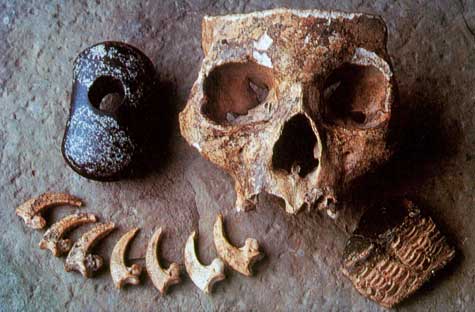
Isbister. Small Finds, including eagle's talons, macehead, potsherd and part of he skull of a young woman.
More careful investigations of the cairn have shown that there were two wall faces within the body of the stonework and revealed about a ten metre stretch of the outer revetment at the northern end. A part of what is presumably the same wall on the western side of the mound stood to a height of about 3 metres above the floor of the tomb. It is estimated that the original edifice measured approximately 11 x 16 metres. At some point after the tomb was erected, a straightish wall of rubble and dressed masonry was built running off to the NNE—it has been speculated that this might have been one of a pair of “hornworks” enclosing a sort of forecourt for the tomb. In fact, no trace of a corresponding wall heading south has been found but the topography more or less fills the bill.
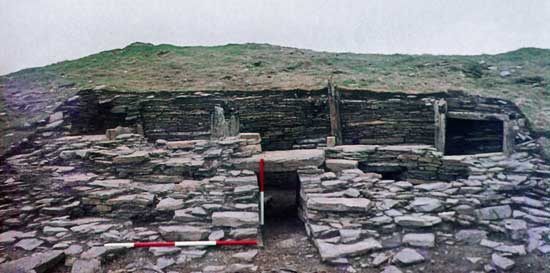
Isbister. Tomb of the Eagles after Excavations
Later still, the tomb was encased in a rubble mound, held in place by a low wall ca. two metres thick. The eastern side of it has been quarried away but it must have been about 30 or so metres across, enclosing the cairn equally in all directions. The associated material—including ground stone axes, a mace head and a jet button with a V-bored perforation—is characteristic of a later phase of the Neolithic, when stone circles dominated the sacred landscape and Maes Howe tombs were the norm. It looks as though the old tomb was decommissioned but suitably commemorated at the same time.

